Zillion adventures (mini-review)
 I already wrote about how easy it is to develop your own game using Zillions of Games , but I did not mention one important consequence of this fact. The set of applications for ZoG is not limited to 375 games and puzzles that are included in the distribution kit. There are really a lot of games developed for Zillions of Games. Dozens of enthusiasts from around the world add to this list using both ZRF and native extensions. To date, its size has already exceeded 2000.
I already wrote about how easy it is to develop your own game using Zillions of Games , but I did not mention one important consequence of this fact. The set of applications for ZoG is not limited to 375 games and puzzles that are included in the distribution kit. There are really a lot of games developed for Zillions of Games. Dozens of enthusiasts from around the world add to this list using both ZRF and native extensions. To date, its size has already exceeded 2000.Of course, I can not tell you about everything that was implemented in the framework of the ZoG project. Today, I will try to tell about the applications that seemed to me especially interesting.
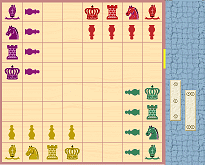 Of course, it should start with the game, considered the progenitor of all modern varieties of chess. This game can be played by the four of us, using dice to complete the moves. It is curious that already in such an ancient game there is a figure “Horse” that is no different from a similar figure in modern Chess.
Of course, it should start with the game, considered the progenitor of all modern varieties of chess. This game can be played by the four of us, using dice to complete the moves. It is curious that already in such an ancient game there is a figure “Horse” that is no different from a similar figure in modern Chess.Of course, Shatranj , considered a direct descendant of Chaturanga, is also available in several versions . Among other “historical-national” varieties, Thai Macruk and Mongolian Hiashatar should be mentioned. The latter is not much different from modern chess.
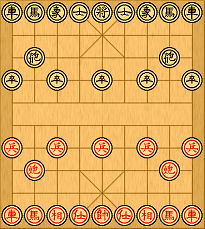 Different varieties of Chinese and Korean chess should be distinguished into a separate family. The moves of the figures are again similar to the rules of traditional chess, but there are important differences. For example, pawns go and eat only forward, there are no takes on the diagonal. A horse cannot “jump over” figures, and the General (the King’s equivalent in Chess) cannot leave his “palace”. A very interesting figure is Cannon. She walks like the Chariot (an analogue of Rook in Chess), but she can take pieces only on the condition that there is another figure (original or alien) between the starting and ending points of the turn.
Different varieties of Chinese and Korean chess should be distinguished into a separate family. The moves of the figures are again similar to the rules of traditional chess, but there are important differences. For example, pawns go and eat only forward, there are no takes on the diagonal. A horse cannot “jump over” figures, and the General (the King’s equivalent in Chess) cannot leave his “palace”. A very interesting figure is Cannon. She walks like the Chariot (an analogue of Rook in Chess), but she can take pieces only on the condition that there is another figure (original or alien) between the starting and ending points of the turn.ZoG can offer us traditional options like Syangsi and Changi . There is also a version with an additional “Dragon” figure, a mini version , an option on 3d and hexagonal boards. A rather interesting game is the traditional set of pieces, against the Korean. Most of the game "Korean" side has some advantage, but in the endgame the situation changes dramatically.
')
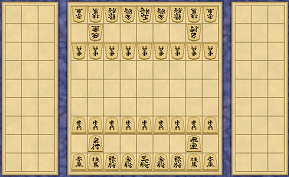 There are many variants of Japanese Shogi , good and different. The Japanese, perhaps, were the most inventive in the development of a variety of chess games. An important difference between most variants of Shogi and Chess is the ability to "reset" the pieces. Removing the opponent's piece from the board, the player does not take her out of the game completely, but keeps it “in hand”. Subsequently, this figure can be exposed to any free board space (subject to a number of rules) already under its “color”. This feature makes the Shogi incredibly dynamic and combination game, despite the fact that the figures Shogi weaker than their chess counterparts.
There are many variants of Japanese Shogi , good and different. The Japanese, perhaps, were the most inventive in the development of a variety of chess games. An important difference between most variants of Shogi and Chess is the ability to "reset" the pieces. Removing the opponent's piece from the board, the player does not take her out of the game completely, but keeps it “in hand”. Subsequently, this figure can be exposed to any free board space (subject to a number of rules) already under its “color”. This feature makes the Shogi incredibly dynamic and combination game, despite the fact that the figures Shogi weaker than their chess counterparts. Of course, Shogi did not remain deprived of the attention of the ZoG community. Beginners can be advised a set of options for the game with different types of "odds", traditionally provided to a weaker player. There are also options for playing mini-boards. Quite exotic are the variants of playing on a one-dimensional board (it should be noted that due to the possibility of "resetting" the figures, the game does not become less interesting). “Historical” options are presented by Tori Shogi , Wa Shogi , Chu Shogi and Dai Dai Shogi . The latter, by the way, is not the “biggest” version of the game. A well-known variety of Taikyoku Shogi was played on a 36x36 cell board. There is the possibility of playing on non-square and three-dimensional boards. Cannon Shogi adds the Chinese Chess Cannon to the game. Quite interesting is the synthetic game Chessgi , which uses a set of traditional chess pieces, but the rules are supplemented by the possibility of "resetting" taken pieces, by analogy with Shogi.
Of course, Shogi did not remain deprived of the attention of the ZoG community. Beginners can be advised a set of options for the game with different types of "odds", traditionally provided to a weaker player. There are also options for playing mini-boards. Quite exotic are the variants of playing on a one-dimensional board (it should be noted that due to the possibility of "resetting" the figures, the game does not become less interesting). “Historical” options are presented by Tori Shogi , Wa Shogi , Chu Shogi and Dai Dai Shogi . The latter, by the way, is not the “biggest” version of the game. A well-known variety of Taikyoku Shogi was played on a 36x36 cell board. There is the possibility of playing on non-square and three-dimensional boards. Cannon Shogi adds the Chinese Chess Cannon to the game. Quite interesting is the synthetic game Chessgi , which uses a set of traditional chess pieces, but the rules are supplemented by the possibility of "resetting" taken pieces, by analogy with Shogi. Chess games on non-square boards are quite numerous. 3D is not the limit of the dimension of the board, there are four and five-dimensional counterparts. There are options for playing on really big boards. Very numerous options with an extended set of figures, such as Alekhine Chess , Capablanca's Chess and Omega Chess Advanced . There are even chess with airplanes . Very interesting options with changing shapes: FlipChess , Fusion Chess and Assimilation Chess . Original and numerous options for playing on hexagonal boards . There are even chess " for three ". There is a game on a board rotated 45 degrees. LadderChess offers to play on the "ladder". Fortresses is devoted to the subtleties of the tactics of battles on a narrow "isthmus" between two "fortresses". DarkChess offers to play in the dark. Very elegant game on the "star" board. There are also a number of mini chess games: Caïssa , Maharadscha , Hunt , Towers , Chad and HexChad .
Chess games on non-square boards are quite numerous. 3D is not the limit of the dimension of the board, there are four and five-dimensional counterparts. There are options for playing on really big boards. Very numerous options with an extended set of figures, such as Alekhine Chess , Capablanca's Chess and Omega Chess Advanced . There are even chess with airplanes . Very interesting options with changing shapes: FlipChess , Fusion Chess and Assimilation Chess . Original and numerous options for playing on hexagonal boards . There are even chess " for three ". There is a game on a board rotated 45 degrees. LadderChess offers to play on the "ladder". Fortresses is devoted to the subtleties of the tactics of battles on a narrow "isthmus" between two "fortresses". DarkChess offers to play in the dark. Very elegant game on the "star" board. There are also a number of mini chess games: Caïssa , Maharadscha , Hunt , Towers , Chad and HexChad .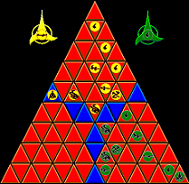 Separate attention deserve the game "based on" various fantastic works. The ancestor of the "chess" genre in literature is, apparently, Edgar Burrows , who described in detail to us " Martian chess ". Of course, the Jetan on the ZoG website is in stock . There is even a " War of the Worlds " with the participation of Martian chess on the one hand with the combined forces of the Earth on the other. Admirers of George Martin can please Cyvasse . The world of Dungeons & Dragons also did not leave us without a game . StarTrek , as it should be, presents us with a whole galaxy of games. We can feel like Klingons playing Klin Zha and its three-dimensional counterpart . There is a game with original figures, based on the series. The famous three-dimensional chess is also present , but I honestly do not understand them.
Separate attention deserve the game "based on" various fantastic works. The ancestor of the "chess" genre in literature is, apparently, Edgar Burrows , who described in detail to us " Martian chess ". Of course, the Jetan on the ZoG website is in stock . There is even a " War of the Worlds " with the participation of Martian chess on the one hand with the combined forces of the Earth on the other. Admirers of George Martin can please Cyvasse . The world of Dungeons & Dragons also did not leave us without a game . StarTrek , as it should be, presents us with a whole galaxy of games. We can feel like Klingons playing Klin Zha and its three-dimensional counterpart . There is a game with original figures, based on the series. The famous three-dimensional chess is also present , but I honestly do not understand them.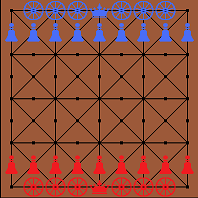 A number of games I find it difficult to attribute to a particular group. First of all, it is, of course, nothing like Hnefatafl . There is a realization of Gala , which, although usually refers to chess, in my opinion, has little in common with them. The various options for combining the rules of Hulme and Chess are also popular . I really liked Andalusia , shown in the picture on the right. There are several games that turn a chessboard into a real maze. Some games just don't look like anything. Of course, many varieties of Checkers , Go , Reversi and Rendzu are also present. Nostalgic memories are caused by the Hex in me, described in time immemorial by Martin Gardner . There is a version of this game that uses a plug-in engine and plays significantly better than its honest ZRF counterpart. For most of the above, you can find many 3D, hexagonal and other clones.
A number of games I find it difficult to attribute to a particular group. First of all, it is, of course, nothing like Hnefatafl . There is a realization of Gala , which, although usually refers to chess, in my opinion, has little in common with them. The various options for combining the rules of Hulme and Chess are also popular . I really liked Andalusia , shown in the picture on the right. There are several games that turn a chessboard into a real maze. Some games just don't look like anything. Of course, many varieties of Checkers , Go , Reversi and Rendzu are also present. Nostalgic memories are caused by the Hex in me, described in time immemorial by Martin Gardner . There is a version of this game that uses a plug-in engine and plays significantly better than its honest ZRF counterpart. For most of the above, you can find many 3D, hexagonal and other clones.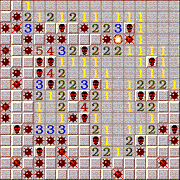 ZoG is not limited to logical and board games, as one might think. She has something to please and casual. There is a good implementation of the well-known Minesweeper . FreeCell offers us a painfully familiar solitaire game. There are many mazes with and without lasers, including three-dimensional ones . You can play Bulls and Cows . Special mention deserves a section of educational applications . Along with the well-known “ Life ” (including its one-dimensional version ) and “ Langton's Ant ”, here you can find implementations of summing and logic machines, as well as a couple of implementations of the Turing machine and something to count CRC . Here you can find the Pentamino problem solver . And fans of “abnormal programming”, I am sure, will be extremely pleased with the implementation of the Calculator .
ZoG is not limited to logical and board games, as one might think. She has something to please and casual. There is a good implementation of the well-known Minesweeper . FreeCell offers us a painfully familiar solitaire game. There are many mazes with and without lasers, including three-dimensional ones . You can play Bulls and Cows . Special mention deserves a section of educational applications . Along with the well-known “ Life ” (including its one-dimensional version ) and “ Langton's Ant ”, here you can find implementations of summing and logic machines, as well as a couple of implementations of the Turing machine and something to count CRC . Here you can find the Pentamino problem solver . And fans of “abnormal programming”, I am sure, will be extremely pleased with the implementation of the Calculator .In general, there is something to see on the ZoG website. All with the upcoming weekend!
Source: https://habr.com/ru/post/214163/
All Articles